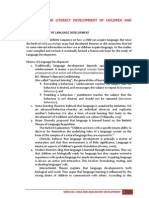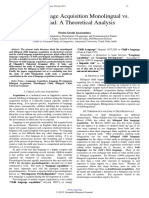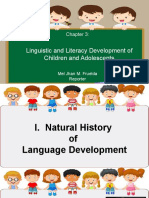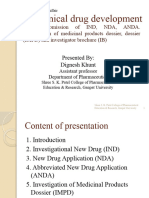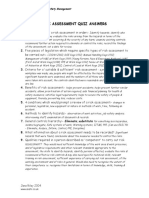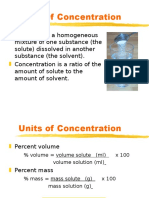0 ratings0% found this document useful (0 votes)
17 viewsBilingualism: Name: 1. Nur Havizzah Suana 2. Suryani 3. Hotnida Simangunsong
Bilingualism: Name: 1. Nur Havizzah Suana 2. Suryani 3. Hotnida Simangunsong
Uploaded by
Neltza SiregarBilingualism refers to the ability to use two languages effectively. Early studies showed mixed results on the cognitive impacts of bilingualism, but a landmark 1962 study in Montreal found that bilingual children performed equally or better than monolingual children on verbal and non-verbal tasks, contradicting predictions. Subsequent studies through the 1990s replicated these positive effects, showing benefits for bilingual children in linguistic and cognitive areas. While bilingualism provides advantages like improved cognitive control and multitasking abilities, it can also lead to dominance of one language and delays in fluency development for children learning two languages simultaneously.
Copyright:
© All Rights Reserved
Available Formats
Download as PPTX, PDF, TXT or read online from Scribd
Bilingualism: Name: 1. Nur Havizzah Suana 2. Suryani 3. Hotnida Simangunsong
Bilingualism: Name: 1. Nur Havizzah Suana 2. Suryani 3. Hotnida Simangunsong
Uploaded by
Neltza Siregar0 ratings0% found this document useful (0 votes)
17 views8 pagesBilingualism refers to the ability to use two languages effectively. Early studies showed mixed results on the cognitive impacts of bilingualism, but a landmark 1962 study in Montreal found that bilingual children performed equally or better than monolingual children on verbal and non-verbal tasks, contradicting predictions. Subsequent studies through the 1990s replicated these positive effects, showing benefits for bilingual children in linguistic and cognitive areas. While bilingualism provides advantages like improved cognitive control and multitasking abilities, it can also lead to dominance of one language and delays in fluency development for children learning two languages simultaneously.
Original Title
Bilingualism
Copyright
© © All Rights Reserved
Available Formats
PPTX, PDF, TXT or read online from Scribd
Share this document
Did you find this document useful?
Is this content inappropriate?
Bilingualism refers to the ability to use two languages effectively. Early studies showed mixed results on the cognitive impacts of bilingualism, but a landmark 1962 study in Montreal found that bilingual children performed equally or better than monolingual children on verbal and non-verbal tasks, contradicting predictions. Subsequent studies through the 1990s replicated these positive effects, showing benefits for bilingual children in linguistic and cognitive areas. While bilingualism provides advantages like improved cognitive control and multitasking abilities, it can also lead to dominance of one language and delays in fluency development for children learning two languages simultaneously.
Copyright:
© All Rights Reserved
Available Formats
Download as PPTX, PDF, TXT or read online from Scribd
Download as pptx, pdf, or txt
0 ratings0% found this document useful (0 votes)
17 views8 pagesBilingualism: Name: 1. Nur Havizzah Suana 2. Suryani 3. Hotnida Simangunsong
Bilingualism: Name: 1. Nur Havizzah Suana 2. Suryani 3. Hotnida Simangunsong
Uploaded by
Neltza SiregarBilingualism refers to the ability to use two languages effectively. Early studies showed mixed results on the cognitive impacts of bilingualism, but a landmark 1962 study in Montreal found that bilingual children performed equally or better than monolingual children on verbal and non-verbal tasks, contradicting predictions. Subsequent studies through the 1990s replicated these positive effects, showing benefits for bilingual children in linguistic and cognitive areas. While bilingualism provides advantages like improved cognitive control and multitasking abilities, it can also lead to dominance of one language and delays in fluency development for children learning two languages simultaneously.
Copyright:
© All Rights Reserved
Available Formats
Download as PPTX, PDF, TXT or read online from Scribd
Download as pptx, pdf, or txt
You are on page 1of 8
BILINGUALISM
NAME: 1. NUR HAVIZZAH SUANA
2. SURYANI
3. HOTNIDA SIMANGUNSONG
HISTORY OF BILINGUALISM
• Bilingualism is the ability of a person or community member to use effective
two languages.
• The first decent study, a well-designed study that showed positive results for
bilingualism was published in 1962.
• Peal and Lambert conducted a study in Montreal comparing French-English
bilingual children with French monolingual children.
• They wanted to design the study properly and show that bilingualism was not
damaging children.
• They predicted that if they designed this study carefully, bilingual children
would perform the same as monolingual children on non-verbal tasks, but worse
than monolingual children on verbal tasks.
• Contrary to the initial predictions, what they found was that bilingual children
were just better on everything.
• So it was the first time there were positive effects of bilingualism in that study
was reasonably well-controlled – not perfectly, but reasonably.
• Through the 1990s the Bialystok group and other researchers started looking at
bilingual consequences for children inspired by the Peal and Lambert research in
order to see the conditions under which the Peal and Lambert results could be
replicated, to see if it could be shown in different groups and other conditions.
• These studies showed that on both linguistic and cognitive tests bilingual
children consistently showed these kinds of benefits over monolingual
children.
6 CATEGORIES FOR LEARNING LANGUAGE
1. Simultaneous acquisition occurs when, for example, a child learns several languages Simultaneously
within social environment. Also called Compound Bilingual.
2. Successive acquisition means. That different languages are learned at different stages during different
phases of life. Called Coordinate Bilingual when the two languages are equally used/ important or
Subordinate Bilingual when one language (Usually the mother/ Native Tongue) dominates the daily life.
3. Natural acquisition means that a language is learned without formal instruction.
4. Guided acquisition means that the knowledge of a language is acquired by means of instructions (e.g
learning at school)
5. Symmetric acquisition means that several languages are equally mastered with a similar proficiency.
6. Asymmetric acquisition means that one language the other.
ADVANTAGES OF BILINGUALISM
1. Access to a larger world
When you learn a language you also learn the culture. Being able to speak two languages means you are able to
speak to people in a different cultural and linguistic contex.
Bilinguals can use the right executive function of the brain more regulary in bilinguals wich makes it become
more effcient.
2.Better ability to focus
The part of the brain called the executive function, which is use for staying focused has proven to be stronger in
bilinguals. Every time a bilingual speaks, both language are actually active, and the brain has to work to
suppress one language while the other is being used. That mechanism employs the executive function of the
brain more regularly in bilinguals which makes it become more efficient.
3. Learning another language stretches your mind intellectually. When you learn another
language you have to focus on the structure of sentences. You have to recognise sound patterns
and make inference
4.Better at multitasking
Bilingual kids can switch from one activity to another faster and are better at doing multiple taks
at once than monolinguals, that is thnaks to the executive function of the brain, which gives
bilinguals better cognitive control over information that allows them to switch task.
5. More job opportunities
Fluency in more one language can open many does
DISADVANTANGES OF BILINGUALISM
1. The dominance of one language over the other. To speak one language more than the other, making one
of language dominant.
2. Prejudice : Bilinguals are not really as celebrated as we though they always were. Most of the people
thought of them as special, however,some people think of them as weird or strange individuals.
Immigrants,especially look different and are somehow still affiliated with their culture. They posses a
strange accent that gives them off and characterizes them as different.
3. Language Flunecy Delay: Most times, speech delay is often confused with language delay.According to
reserch, it has been discovered that speech delay is not as result of bilingualism, however sice an
individual is trying to learn or master two languages, he or she ( especially children) may take a longer
time being fluent in these languages resulting in language fluency delay. Monolingual children are
usually compared with their monolingual age group, without considering the fact that they have to learn
twice the vocabullary of their monolingual peers.In extreme cases,some children speak at all. However
if your child is in this category , don’t panic just yet, he should be able to speak in time.
You might also like
- Catcher in The Rye AnnotationsDocument21 pagesCatcher in The Rye Annotationsapi-611717663No ratings yet
- Standard Detail Drawings Cathodic ProtectionDocument15 pagesStandard Detail Drawings Cathodic ProtectionanNo ratings yet
- Kendra CherryDocument4 pagesKendra CherrymartingolicruzNo ratings yet
- Report On Comparison of Series and Shunt CompensationDocument31 pagesReport On Comparison of Series and Shunt CompensationRam Uday Mandal67% (3)
- Book Data Fats That Heal Fats That KillDocument5 pagesBook Data Fats That Heal Fats That Killnandoperu33% (3)
- Bilingualism and Second Language AcquisitionDocument15 pagesBilingualism and Second Language AcquisitionFimelNo ratings yet
- Second Language Acquisition in Early ChildhoodDocument6 pagesSecond Language Acquisition in Early ChildhoodMaria Carolina MejiaNo ratings yet
- Assessing Language Development in Bilingual Preschool Children Part II: Language Development in Bilingual ChildrenDocument5 pagesAssessing Language Development in Bilingual Preschool Children Part II: Language Development in Bilingual Childrenapi-27788847No ratings yet
- 1 The Antecedents of Language DevelopmentDocument43 pages1 The Antecedents of Language DevelopmentLara100% (2)
- BilingualismDocument5 pagesBilingualismAlushka OthmanNo ratings yet
- What Is BilingualismDocument4 pagesWhat Is Bilingualismserik.seifullinNo ratings yet
- Group 5 Report 1Document16 pagesGroup 5 Report 1Nevernever EverNo ratings yet
- Early Childhood Bilingualism G2Document5 pagesEarly Childhood Bilingualism G2s.digal.carmelbenedictNo ratings yet
- S1, Psycholinguistics 1Document9 pagesS1, Psycholinguistics 1Rayene MedabisNo ratings yet
- Final Module in Principles and Theories in Language AcquisitionDocument14 pagesFinal Module in Principles and Theories in Language AcquisitionChristel VirtucioNo ratings yet
- Questions About The ArticleDocument4 pagesQuestions About The ArticleInma RdNo ratings yet
- Seminar Paper - RevisionsDocument22 pagesSeminar Paper - RevisionsMikhael O. SantosNo ratings yet
- REading Comprehension Tema 4 When - Families - Speak More Than Two LanguagesDocument12 pagesREading Comprehension Tema 4 When - Families - Speak More Than Two LanguagesSuraya Meri VargasNo ratings yet
- Linguistic and Literacy Development of Children and AdolescentsDocument2 pagesLinguistic and Literacy Development of Children and Adolescentsarmandstore1234No ratings yet
- Language AcquistiionDocument6 pagesLanguage AcquistiionShady AbuyusufNo ratings yet
- Linguistic and Literacy Development of Children and AdolescentsDocument2 pagesLinguistic and Literacy Development of Children and AdolescentsPeter CampilanNo ratings yet
- Makalah SosioDocument4 pagesMakalah SosioSaiful HudaNo ratings yet
- NnellDocument4 pagesNnellapi-296445698No ratings yet
- Zurich Is German Teachers Switzerland TOKUHAMA Ten Key Factors 2Document219 pagesZurich Is German Teachers Switzerland TOKUHAMA Ten Key Factors 2sammlissNo ratings yet
- Educ 101 ReviewerDocument50 pagesEduc 101 ReviewerTom Cyrus VallefasNo ratings yet
- Fostering Second Language Development in Young Children: October 1995Document6 pagesFostering Second Language Development in Young Children: October 1995api-27788847No ratings yet
- DEI - Young LearnersDocument11 pagesDEI - Young LearnersRoxana AndreaNo ratings yet
- Before Reading QuestionsDocument4 pagesBefore Reading QuestionsInma RdNo ratings yet
- Language Acquisition....Document11 pagesLanguage Acquisition....Arooj FatimaNo ratings yet
- Linguistic and Literacy Development of Children and AdolescentsDocument11 pagesLinguistic and Literacy Development of Children and AdolescentsLizze Agcaoili ArizabalNo ratings yet
- Child Language Acquisition Monolingual vs. Bilingual: A Theoretical AnalysisDocument4 pagesChild Language Acquisition Monolingual vs. Bilingual: A Theoretical Analysisrobert0rojerNo ratings yet
- Benefits and Drawbacks of Learning A Second LanguageDocument3 pagesBenefits and Drawbacks of Learning A Second Languagedian angreaniNo ratings yet
- 1 StandsndtheoriesDocument88 pages1 StandsndtheoriesMeli MacielNo ratings yet
- El104 Final Content (Arciga, Rhea Mae)Document2 pagesEl104 Final Content (Arciga, Rhea Mae)Rhea Mae ArcigaNo ratings yet
- Module 3 Linguistic and Literary Development of Children and AdolescentDocument8 pagesModule 3 Linguistic and Literary Development of Children and Adolescentjaz bazNo ratings yet
- Childhood Bilingualism 3rd Year S2Document4 pagesChildhood Bilingualism 3rd Year S2Bensalem ImeneNo ratings yet
- 4 Cognitive Development - LanguageDocument66 pages4 Cognitive Development - LanguageAarushiNo ratings yet
- Tefl Mid TestDocument15 pagesTefl Mid TestSayyidah BalqiesNo ratings yet
- Linguistic and Literacy Dev of Children and AdolescentsDocument28 pagesLinguistic and Literacy Dev of Children and AdolescentsMel Jhan Mignon FrueldaNo ratings yet
- Raising Bilingual Children: Tips For Using More Than One Language With Your ChildDocument2 pagesRaising Bilingual Children: Tips For Using More Than One Language With Your Childdavid laraNo ratings yet
- Learning Activity 3: University of Eastern PhilippinesDocument6 pagesLearning Activity 3: University of Eastern PhilippinesMary May Esmerio BalagbisNo ratings yet
- LanguageDocument30 pagesLanguageAluko WemimoNo ratings yet
- Children As Language LearnersDocument20 pagesChildren As Language LearnersFey'sNo ratings yet
- Languge Programs and Policies in Multilingual Societies Lesson 1 9Document87 pagesLanguge Programs and Policies in Multilingual Societies Lesson 1 9Lucas XiiNo ratings yet
- An Introduction To The Second Language Acquisition: September 2017Document24 pagesAn Introduction To The Second Language Acquisition: September 2017Azam KhujamyorovNo ratings yet
- First Language AcquisitionDocument10 pagesFirst Language Acquisitionramita ami100% (1)
- History of Language Development and Concepts Bilingualism: Lesson 1Document5 pagesHistory of Language Development and Concepts Bilingualism: Lesson 1Cayla Jen Basalan BunghanoyNo ratings yet
- Age and Acquisition: Principles of Language Learning and Teaching H. Douglas BrownDocument17 pagesAge and Acquisition: Principles of Language Learning and Teaching H. Douglas BrownLuciaNo ratings yet
- 1 Assignment No.2: First Language AcquisitionDocument10 pages1 Assignment No.2: First Language AcquisitionSajdah ImtiazNo ratings yet
- MTB MLE Unit 1Document14 pagesMTB MLE Unit 1Analou Delfino100% (1)
- Foreign Language AcquisitionDocument22 pagesForeign Language AcquisitionyansyarroyoNo ratings yet
- Multilingual Is MDocument6 pagesMultilingual Is MHelenNo ratings yet
- Main Reference BookDocument16 pagesMain Reference BookYuriy KondratiukNo ratings yet
- First - Language - Acquisition by Team 1Document14 pagesFirst - Language - Acquisition by Team 1Aliviah Nabila Putri100% (1)
- Module 2Document96 pagesModule 2Aditya parasNo ratings yet
- Theories of Second Language Acquisition: Assessment/ EvaluationDocument2 pagesTheories of Second Language Acquisition: Assessment/ EvaluationrevinNo ratings yet
- The Difference Between Multilingualism and PlurilingualismDocument7 pagesThe Difference Between Multilingualism and PlurilingualismKhenjeza PornelaNo ratings yet
- Summary 7Document5 pagesSummary 7srie novita windaNo ratings yet
- Module N1 Intro To SlaDocument4 pagesModule N1 Intro To SlaAna J. Del Cid G.No ratings yet
- El 103 - Age and AcquisitionDocument40 pagesEl 103 - Age and AcquisitionLevie Alpos50% (2)
- Promoting Literacy in The Spanish Education ClassroomDocument5 pagesPromoting Literacy in The Spanish Education Classroomapi-301896424No ratings yet
- Multilingualism, Language Planning and EducationDocument27 pagesMultilingualism, Language Planning and EducationAlba Beltrán100% (1)
- A Short Guide To Raising Children BilinguallyDocument9 pagesA Short Guide To Raising Children BilinguallyGaius DesdunNo ratings yet
- 12 Myth MisconceptionsDocument2 pages12 Myth Misconceptionstheberkeleymom100% (1)
- StoryFrames: Helping Silent Children to Communicate across Cultures and LanguagesFrom EverandStoryFrames: Helping Silent Children to Communicate across Cultures and LanguagesNo ratings yet
- The Summary of The Media & Social RelationshipsDocument11 pagesThe Summary of The Media & Social RelationshipsNeltza SiregarNo ratings yet
- The Concept of Cohesion Is A Semantic OneDocument3 pagesThe Concept of Cohesion Is A Semantic OneNeltza SiregarNo ratings yet
- Illocutionary Speech NeltzaDocument10 pagesIllocutionary Speech NeltzaNeltza SiregarNo ratings yet
- Femme Fatale Kila NeltzaDocument5 pagesFemme Fatale Kila NeltzaNeltza SiregarNo ratings yet
- Split Cherry Tree-SemioticDocument13 pagesSplit Cherry Tree-SemioticNeltza SiregarNo ratings yet
- Analysis Deconstruction The Friday Everything ChangedDocument11 pagesAnalysis Deconstruction The Friday Everything ChangedNeltza SiregarNo ratings yet
- Prose Analysis: Neltza Sister Siregar Sormin 1879202012 2019/2020Document10 pagesProse Analysis: Neltza Sister Siregar Sormin 1879202012 2019/2020Neltza SiregarNo ratings yet
- Prose Analysis I - Semiotic Theory Analysis Into The Tell-Tale Heart by Edgar Allan PoeDocument12 pagesProse Analysis I - Semiotic Theory Analysis Into The Tell-Tale Heart by Edgar Allan PoeNeltza SiregarNo ratings yet
- 07 - Dual-Phase Stimulated Raman Scattering Microscopy For Real-Time Two-Color ImagingDocument4 pages07 - Dual-Phase Stimulated Raman Scattering Microscopy For Real-Time Two-Color Imagingyoussef ahmadNo ratings yet
- VIVA Survey by DR Nappi Climacteric 2012Document9 pagesVIVA Survey by DR Nappi Climacteric 2012The Vancouver SunNo ratings yet
- Non Clinical Drug DevelopmentDocument75 pagesNon Clinical Drug DevelopmentalexNo ratings yet
- Mark Scheme: Assessment Unit A2 1Document10 pagesMark Scheme: Assessment Unit A2 1chowdhuryNo ratings yet
- College of Arts & Sciences: Google Meet Link - 1 Semester AY 2022-2023Document2 pagesCollege of Arts & Sciences: Google Meet Link - 1 Semester AY 2022-2023TrixieNo ratings yet
- Xyiqlr: Reservation DetailsDocument5 pagesXyiqlr: Reservation DetailsxxxNo ratings yet
- RISK ASSESSMENT QUIZ ANSWERS (Confer)Document1 pageRISK ASSESSMENT QUIZ ANSWERS (Confer)Roh Young songNo ratings yet
- Acme Laboratories Ltd. - Unsolicited-PtdDocument13 pagesAcme Laboratories Ltd. - Unsolicited-PtdnasirNo ratings yet
- G11 Christian Values EducationDocument7 pagesG11 Christian Values EducationAzory ZelleNo ratings yet
- Concepts of FaithDocument9 pagesConcepts of FaithcalebNo ratings yet
- P Silo Cyn ExtractionDocument4 pagesP Silo Cyn ExtractionSmokeNo ratings yet
- Crim311 Week 14 1ST Sem 22-23Document16 pagesCrim311 Week 14 1ST Sem 22-23Eduardo FriasNo ratings yet
- The Children Eating Behavior Inventory CebiDocument15 pagesThe Children Eating Behavior Inventory CebiNina SalinasNo ratings yet
- Dry Cooling Systems-ServiceDocument13 pagesDry Cooling Systems-ServiceZdravko IvancicNo ratings yet
- Universal Safety (Health) PrecautionsDocument61 pagesUniversal Safety (Health) Precautionstummalapalli venkateswara rao100% (2)
- SeedList Common Scientific PDFDocument26 pagesSeedList Common Scientific PDFJaved JavesNo ratings yet
- Biofuel PresentationDocument37 pagesBiofuel PresentationshahzebNo ratings yet
- Electric Scooter (E-Scooter) Riders Training and QualificationsDocument19 pagesElectric Scooter (E-Scooter) Riders Training and QualificationsshoaibNo ratings yet
- Fan Indent - BHW June15Document4 pagesFan Indent - BHW June15Rajesh TipnisNo ratings yet
- 04 09 Cherukuri 540 - PPT PDFDocument52 pages04 09 Cherukuri 540 - PPT PDFRajeev SagiNo ratings yet
- Ellen White - Life Legacy and RelevanceDocument63 pagesEllen White - Life Legacy and Relevancewand SoaresNo ratings yet
- Exothermic Welding Powder SDS SunlightDocument7 pagesExothermic Welding Powder SDS Sunlightosmar barzola sotoNo ratings yet
- Accenture Healthcare Industry SlideshareDocument13 pagesAccenture Healthcare Industry SlideshareNitin AmesurNo ratings yet
- Bullet Train (Early Draft)Document122 pagesBullet Train (Early Draft)Lord SkywalkerNo ratings yet
- Concentration of SolutionsDocument15 pagesConcentration of SolutionsswamyforuNo ratings yet





























